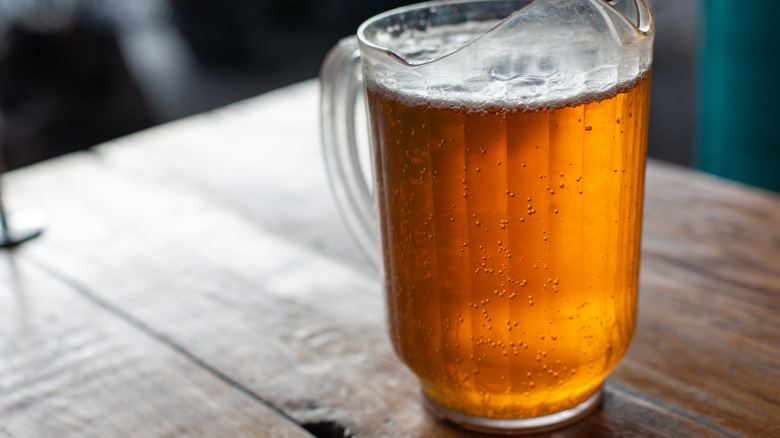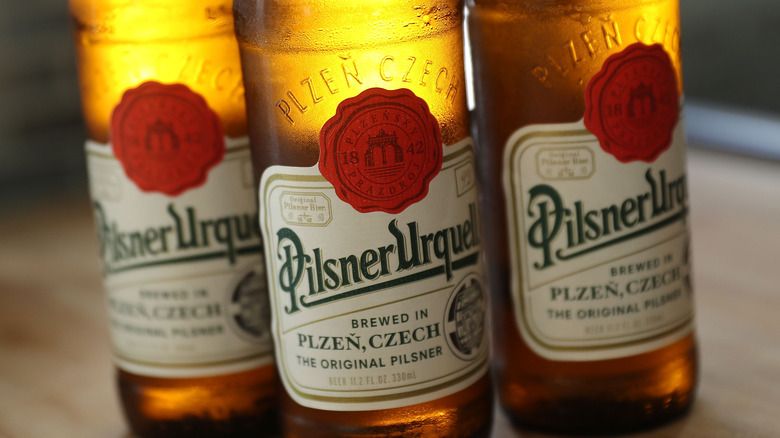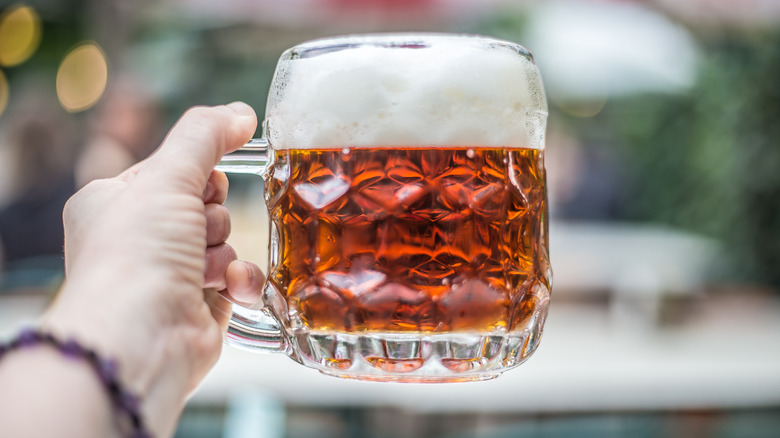The Malty Difference Between Pilsner And Lager Beers
Most beer can be categorized as either lager or ale, but within these broad classifications, there exists a wide variety of popular beer styles.
Pilsner, for example, is a kind of lager, meaning a beer that's fermented at relatively chilly temperatures (between 35 and 50 degrees Fahrenheit) using bottom-fermenting yeast. However, despite this lager fermentation — and the fact that pilsner undergoes a traditional lagering maturation process — pilsners are a distinct type of lager, distinguished by their signature pilsner malt, made exclusively from a modified type of malted barley. Pilsners are light, in the range of about 5% ABV (alcohol by volume), with a pale blonde color. Due to their higher hops content compared to most lagers, pilsners have a spicier flavor than their light color and crisp, carbonated mouthfeel might suggest.
Less than 200 years after its invention, pilsner is now an incredibly popular type of beer style, and some of the most beloved beer brands in the world make pilsners. This includes Pilsner Urquell, the Czech Republic-based brand whose original brewer is credited with inventing the pilsner beer style.
The history of pilsner
In 1842, Josef Groll brought lager yeast from his native Bavaria to the Czech Republic to brew the first pilsner on behalf of the Pilsen-based brewery that would later become famous as Pilsner Urquell. All the beer's other ingredients were from the Czech Republic. Bohemian Saaz hops, for example, gave the beer its signature spiciness, while its malted barley was sourced from Moravia. According to Pilsner Urquell, this barley was originally of the Haná variety, which is considered "the Rolls-Royce of grain."
Groll was only employed in Pilsen for a short time (he returned to Germany in 1845), but the fame of his golden brew soon spread across Europe, thanks to the railroads and emerging refrigeration and pasteurization technology. By the time his one-time employers got around to trademarking the pilsner name in 1859, it was too late. The new beer style was becoming ubiquitous in the marketplace (although the Czech Republic is still the country that drinks the most beer).
Soon, Czech brands like Budweiser Budvar (yes, from the same town where the American brand got its name) were making pilsners, as were German beermakers like Beck's, König, and St. Pauli Girl, brewing companies in the Netherlands like Amstel, Grolsch, and Heineken, and Belgium brewers like Stella Artois.
The major pilsner styles and how they differ
Some major American brands like Budweiser make pilsner-style beers, but because they're not exclusively made with malted barley, they don't technically qualify for the name. Nonetheless, American Pilsner is considered one of the many sub-categories of the beer style made today, along with Bohemian Pilsner, German Pilsner, European Pilsner, and others.
What differences can be noted in these regional styles? In Germany, the beer is referred to as "pils" instead of pilsner, and it features less malt and hops than the original Bohemian version. European Pilsner, the name given to the beer as it's brewed in Belgium and the Netherlands, is typically a bit sweeter than either the Bohemian or German varieties. American Pilsner is notable for its sweetness too, but more so for the fact that it uses rice and corn along with malted barley as its fermentable grains. The latter still accounts for about 75%, but this is the least traditional of the major pilsner styles.
Because of its non-traditional character, many American pilsners are billed as lagers. Miller Lite, for example, boasts of its pilsner status, but Budweiser, despite its pilsner style, is typically referred to as an American-style lager.



